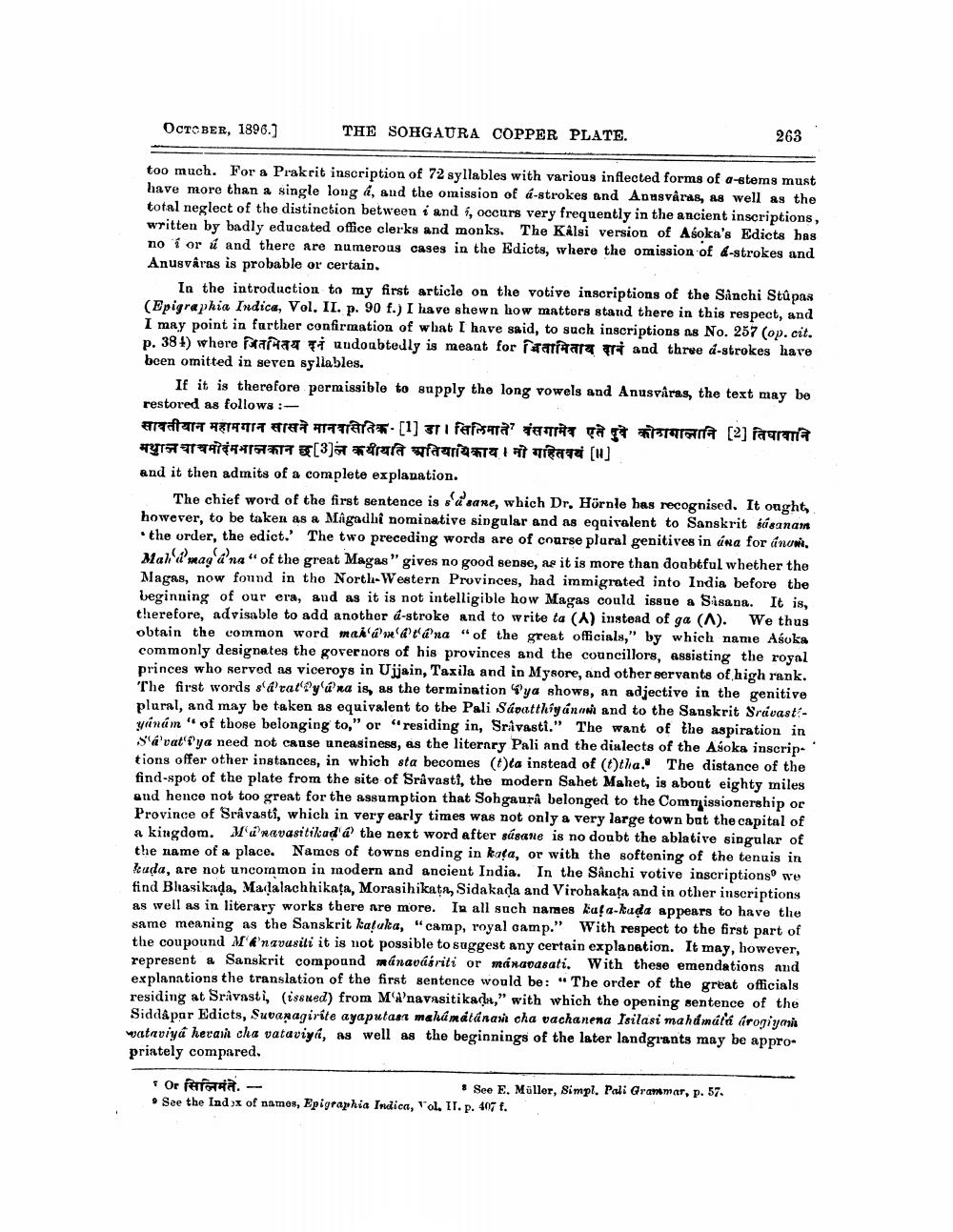________________
OCTOBER, 1896.]
too much. For a Prakrit inscription of 72 syllables with various inflected forms of a-stems must have more than a single long a, and the omission of á-strokes and Anusvaras, as well as the total neglect of the distinction between i and i, occurs very frequently in the ancient inscriptions, written by badly educated office clerks and monks. The Kalsi version of Asoka's Edicts has no i or ú and there are numerous cases in the Edicts, where the omission of 4-strokes and Anusvaras is probable or certain.
THE SOHGAURA COPPER PLATE.
In the introduction to my first article on the votive inscriptions of the Sanchi Stúpas (Epigraphia Indica, Vol. II. p. 90 f.) I have shewn how matters stand there in this respect, and I may point in further confirmation of what I have said, to such inscriptions as No. 257 (op. cit. p. 384) where fara undoubtedly is meant for farfarar and three d-strokes have been omitted in seven syllables.
263
If it is therefore permissible to supply the long vowels and Anusviras, the text may be restored as follows:
सावतीयान महामगान सासने मानवासेतिक [1] डा। सिलिमाते? वंसगामेव एते दुवे को गालानि [2] तिघावानि मथुराज चाचमोदमभाजकान छ [3] लं कययति अतियायिकाय । नो गहितवयं [ ॥ ]
and it then admits of a complete explanation.
The chief word of the first sentence is s'asane, which Dr. Hörnle has recognised. It ought, however, to be taken as a Magadhi nominative singular and as equivalent to Sanskrit sasanam the order, the edict.' The two preceding words are of course plural genitives in úna for anom. Mahamag ana" of the great Magas" gives no good sense, as it is more than doubtful whether the Magas, now found in the North-Western Provinces, had immigrated into India before the beginning of our era, and as it is not intelligible how Magas could issue a Sisana. It is, therefore, advisable to add another á-stroke and to write ta (A) instead of ga (A). We thus obtain the common word mak''m'@'t'a'na "of the great officials," by which name Aśoka commonly designates the governors of his provinces and the councillors, assisting the royal princes who served as viceroys in Ujjain, Taxila and in Mysore, and other servants of high rank. The first words s'a'cat'Py'a'na is, as the termination ya shows, an adjective in the genitive plural, and may be taken as equivalent to the Pali Sávatthiyanah and to the Sanskrit Srávast!yanam" of those belonging to," or "residing in, Srivasti." The want of the aspiration in S'a'vat'iya need not cause uneasiness, as the literary Pali and the dialects of the Asoka inscriptions offer other instances, in which sta becomes (t)ta instead of (t)tha. The distance of the find-spot of the plate from the site of Srâvasti, the modern Sahet Mahet, is about eighty miles and hence not too great for the assumption that Sohgaurâ belonged to the Commissionership or Province of Srâvasti, which in very early times was not only a very large town but the capital of a kingdom. Ma'navasitikad a' the next word after sásane is no doubt the ablative singular of the name of a place. Names of towns ending in kata, or with the softening of the tenuis in kada, are not uncommon in modern and ancient India. In the Sânchi votive inscriptions we find Bhasikada, Madalachhikata, Morasihikata, Sidakada and Virohakata and in other inscriptions as well as in literary works there are more. In all such names kata-kada appears to have the same meaning as the Sanskrit katuka, "camp, royal camp." With respect to the first part of the coupound Ma'navusiti it is not possible to suggest any certain explanation. It may, however, represent a Sanskrit compound mánaváśriti or mánavasati. With these emendations and explanations the translation of the first sentence would be: "The order of the great officials residing at Sravasti, (issued) from M'a'navasitikada," with which the opening sentence of the Siddapar Edicts, Suvanagirite ayaputasa mahámátánami cha vachanena Isilasi mahámáta árogiyas wataviya heram cha vataviya, as well as the beginnings of the later landgrants may be appropriately compared.
Or सिलिमंते.
See the Index of names, Epigraphia Indica, Vol. II. 1
See E. Müller, Simpl. Pali Grammar, p. 57. P. 407 f.




